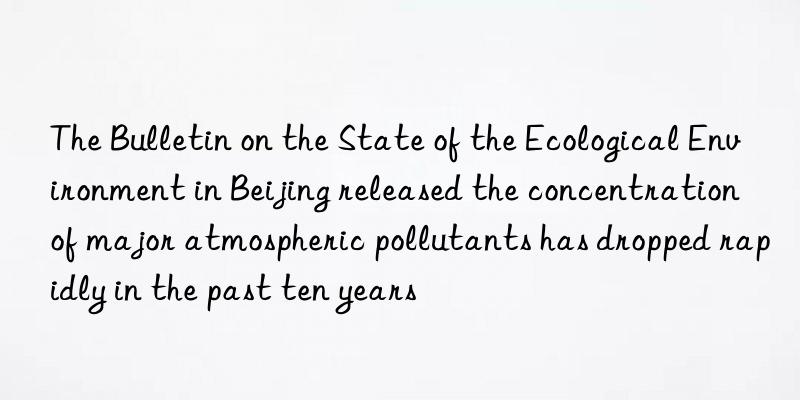
On the 29th, the Beijing Municipal Bureau of Ecology and Environment issued the "2022 Beijing Ecological Environment Status Bulletin" (hereinafter referred to as the "Gazette"). The "face value" of Beijing's ecology has changed over the years.
According to the "Communication", in the past ten years, Beijing has achieved a rapid decline in the concentration of major pollutants in the atmospheric environment while achieving high-quality economic and social development. Compared with 2013, the annual average concentrations of PM2.5, PM10, NO2, and SO2 in 2022 will drop by more than half. Among them, the average annual concentration of PM2.5 dropped from 89.5 micrograms per cubic meter to 30 micrograms per cubic meter, a cumulative decrease of nearly 60 micrograms per cubic meter.
The "Gazette" shows that in 2022, the annual average concentration of fine particulate matter (PM2. The environmental quality remains stable, the radiation environment quality remains normal, the ecological environment continues to improve, and the carbon dioxide emissions per 10,000 yuan of regional GDP maintain the best level in the country's provincial regions.
The annual average concentration of PM2.5 has reached the second-level national air quality standard for two consecutive years
According to the Bulletin, in 2022, PM2.5 in Beijing's atmospheric environment will be 30 micrograms per cubic meter, reaching the national secondary standard for two consecutive years, sulfur dioxide (SO2), nitrogen dioxide (NO2) and inhalable particulate matter The average annual concentrations of (PM10) are 3, 23 and 54 micrograms per cubic meter, which have reached the standard for many years and maintained a downward trend overall.
Over the past ten years, while Beijing has achieved high-quality economic and social development, it has achieved a rapid decline in the concentration of major pollutants in the atmospheric environment.
Compared with 2013, the annual average concentrations of PM2.5, PM10, NO2, and SO2 in Beijing will drop by more than half in 2022. Among them, the average annual concentration of PM2.5 dropped from 89.5 micrograms per cubic meter to 30 micrograms per cubic meter, a cumulative decrease of nearly 60 micrograms per cubic meter. The annual average concentration of SO2 has dropped from 26.5 micrograms per cubic meter to 3 micrograms per cubic meter, a drop of 88.7%, and has remained extremely low for many years, basically equivalent to the level of major cities in developed countries in the world. The number of good and good days was 286 days, an increase of 110 days; the number of heavy pollution days was reduced from 58 days to 3 days. The number of good days has increased significantly, the number of bad days has decreased significantly, and the overall air quality has improved significantly. The effectiveness of atmospheric governance has been hailed as the "Beijing Miracle" by the United Nations Environment Programme.
Dynamically eliminate inferior V water bodies
The "Gazette" shows that in 2022, the quality of Beijing's water environment will continue to improve, the annual average concentration of major surface water pollution indicators will continue to decrease, and the inferior V water bodies will be dynamically eliminated. Groundwater quality remained stable. The water ecology is in good condition.
Over the past ten years, Beijing's water ecological environment has undergone qualitative changes. The proportion of high-quality water bodies has increased significantly. In 2022, a total of 105 sections of rivers in the five major river systems will be monitored, with a length of 2,551.6 kilometers. Inferior Class V water bodies are dynamically eliminated. The water ecology is in good condition, and the water ecology of more than half of the city's rivers has reached an excellent level. Aquatic insects such as mayflies, stoneflies, and stone moths that are often used to indicate clean water are not only common in mountainous rivers, but also "appear" in rivers in plain areas such as Liangshui River, Dashi River, and Liangma River. The five major rivers in the city reappeared as "flowing rivers" and penetrated into the sea; the water volume of Miyun Reservoir hit a record high, and was rated as the first batch of excellent cases of "beautiful rivers and lakes" in the country by the Ministry of Ecology and Environment... The water is clear and the banks are green, the fish fly in the shallow bottom, The scene of harmony between human and water has become the norm.
Forest coverage increased to 44.8% by 2022
The "Gazette" shows that in 2022, Beijing's ecological environment quality index (EI) will be 71.1, achieving continuous improvement for many years, the ecological environment is in good condition, and the quality and stability of the ecosystem continue to improve. The city's forest coverage rate will increase from 38.6% in 2013 to 44.8% in 2022. The city's ecosystem types will continue to be enriched, its stability will gradually increase, and its sustainability will continue to improve.



 微信扫一扫打赏
微信扫一扫打赏
